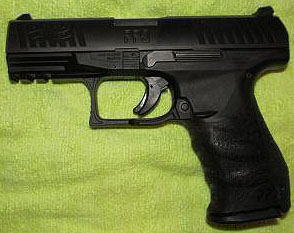|
Walther�s PPQ 9x19mm Pistol � �Die Neue P99� By David Tong  This article will discuss the 2011 introduction of the Walther PPQ pistol and how it is a standout among the current service pistol offerings. Many G&S Online readers are familiar with the late-1990's P99. It was Walther�s delayed entry into the �polymer-framed, striker-fired� (PFSF) genre of service pistols. That pistol utilized Walther�s original double-action first shot, single action repeat shot pattern, established way back in the 1920s, while also embracing the most common trends in modern construction and design elements. The PPQ (standing for �Police Pistol Quick Defense�) differs from the original P99 in that it�s trigger mechanism has been changed to adopt a Glock-like single pull, eliminating the decocking button and adding ambidextrous slide stop levers. Detail changes also include the elimination of the striker protrusion from the rear of the slide, some re-thinking of the grip ergonomics and adding a Picatinny accessory rail to the dust cover area for the fitment of lasers and lights. The primary attractions of the pistol to this seasoned user would be the ergonomics and trigger pull. Specifications
Initial Impressions If anything, the shape of the butt improves upon the already excellent feel of the P99. The shape was always rather �rounder� than most high-capacity pistols and this ovoid shape has been improved and made less angular. The molded stippling of the fiberglass reinforced plastic frame provides a solid yet snag-free grip surface. The area near the web of your hand has a straight tang, unlike the oddly-downswept P99 butt. The slide releases, magazine release levers and takedown switches are completely ambidextrous, making using the PPQ very convenient for lefties. There are those used to a button magazine release who find the downward swinging levers on the Walther to be off-putting. I did not find them so, having had much experience with the H&K USP series, as well as the P99. It affords a quick magazine drop without breaking one�s grip to hit the button. The ergonomics are great and there are three removable backstrap inserts. The finish of all metal parts, save some internals, is Tenifer, making it nearly corrosion proof. Tenifer is applied to the slide, sights and barrel. Magazines are shared with the P99 variants, thus somewhat simplifying acquisition. One must specify standard or compact lengths. The sights are made of steel, not plastic, and the rear sight is screw-adjustable for windage. The rated trigger pull is 5.5 pounds, the same as a standard Glock. However, the trigger of the sample reviewed here feels lighter by at least a half pound. It is clean when the sear drops the striker and the reset is among the shortest of any modern pistol. What is interesting is that the PPQ does not meet German police specifications, due to its better than average trigger pull. Those specs call for a minimum pull weight of 6.7 pounds, the same stroke length and double the reset distance (0.2�). As a result, they classify the PPQ as suitable only for special operations personnel. Shooting observations Since I have extensive experience with the parent P99, I did not expect many surprises with the PPQ. Handling, balance and accuracy should be similar. I fired three, five-shot groups at 25 yards using two brands of ammunition. This included Federal American Eagle 115 grain FMJ (hardball) and Remington 115 grain JHP factory loads. These are standard pressure 9x19mm loads. Walther states that the PPQ�s durability could be compromised by using +P ammunition and asks the owner not to use �+P+� ammo, due to no coherent industry-wide standards for those elevated pressures. Shooting Results:
The overall average group size was 3.5�, a little worse than average for a modern, service type autoloader. The PPQ provided sufficient accuracy for center of mass shots at human size targets out to 25 yards, although I suspect that had premium quality ammunition been avilable the groups would have shrunk somewhat. While the trigger is not as good as several single-action-only designs, it is more than adequate and the design offers all the usual advantages of striker fired, polymer frame psitols: lighter weight, more compact size and somewhat reduced cost. Its thickness may become an issue for some folks, but this is endemic to nearly all PFSF, high capacity pistols. I hope that the new Walther USA company is able to improve upon the parts, magazine supply and customer service issues that have plagued the brand since the closing days of Interarms (their longtime importer until the late 1990s). The PPQ is highly competitive in today�s marketplace and would make an excellent first semi-automatic pistol. It has features that make it a great choice for the experienced hand, as well. |